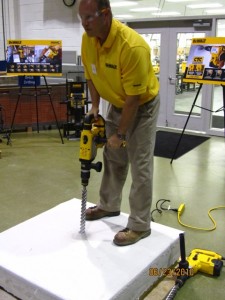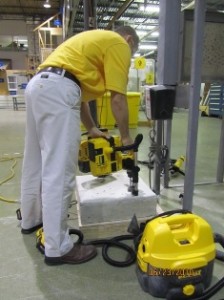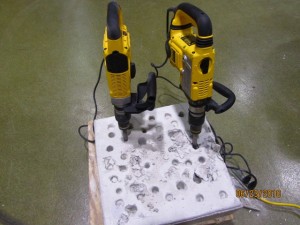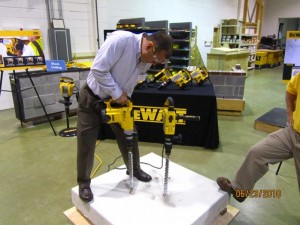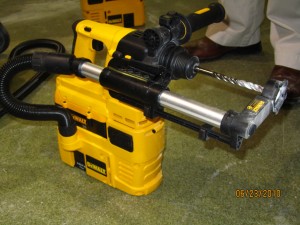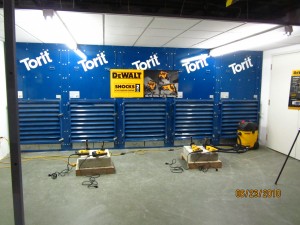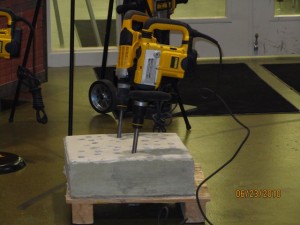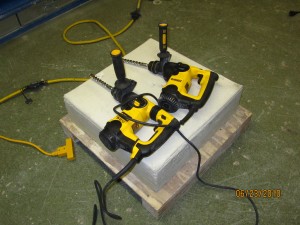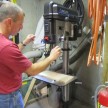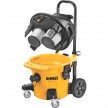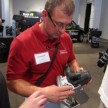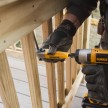DEWALT Rotary And Demolition Hammers
All About DEWALT’s Rotary and Demolition Hammers:
Recently I visited DEWALT’s testing and training facility in Maryland: the Black and Decker University – a very interesting place for anyone who likes tools!
While there I had the opportunity to meet Jeff Beck, Product Manager for rotary and demolition hammer drills. Jeff was willing to be interviewed and I’m pleased to share that with you here.
Concord Carpenter: Jeff, tell us a little about yourself.
Jeff Beck: I’m the Product Manager for DEWALT Rotary And Demolition Hammers. I’ve been with DEWALT for 17 years through a variety of roles on the Industrial / Commercial side of business.
CC: DEWALT is fortunate to have you on their team. When we met at the DEWALT media event in May, I picked up on your passion about the hammers. Tell us about that.
JB: Since the start of my career, hammers have been my favorite category. It’s not hard to be passionate about hammers when you see what DEWALT has done over the last several years, improving on quality and performance while at the same addressing user needs like reduced vibration. A great example is the latest launch of our new Spine & SDS Max Hammers that offer user features such as SHOCKS, Active Vibration control and Complete Torque control [CTC] – all without increasing the weight off the product. It’s very exciting.
CC: Working for DEWALT for 17 years I’m sure you’ve seen a ton of new innovations. As interesting as those features may be, many folks out there might not even know the difference between a drill and a hammer drill. Would you explain that difference?
JB: “Hammer drill” can be a vague term. Tools that rotate a bit and hit at the same time are sometimes referred to as hammer drills. We refer to “hammer drills” as a drill with hammering action that has a standard keyed or key-less chuck that accepts round shank drill bits. A “hammer drill” derives its hammering action from two cams or clutch plates that ride over each other; this doesn’t generate a great deal of hitting force. A “hammer” refers to a tool with and electro-pneumatic mechanism that generates a lot of hitting force. The act of “hammer drilling” is using a tool that generates impact on the nit and rotates the bit at the same time. In “hammers” you will find combination rotary hammers which “hammer drill” and hammer only (chisel or chipping) and these tools commonly use either SDS, Spline or SDS Max bits.
There are also hammers that do not rotate and only generate hitting power [chiseling or chipping], and these are referred to as Chipping or Demolition hammers.
CC: Earlier you mentioned SDS and SDS Max hammers. How many “hammer drills” does DEWALT produce?
JB: DEWALT currently manufacturers 29 combination and chipping / demo hammers.
CC: Why so many?
JB: The reason for the large number of hammers is due to many factors, including: performance level; handle configuration; bit type, and other features. For example, we manufacture 16 SDS units but in that group we have two pistol grip nits, three D-handle units, three L-shaped units, one 1/8 inch unit, three 18V Cordless units, one 24V cordless unit and two 36V units. This is done to provide the user with a tool that best matches up to his/her needs and preferences. Some users prefer to have a specific handle design performance level or lower vibration level. In hammer drills larger than SDS+ there are two common bit systems: Spline and SDS Max. Therefore, we offer the same hammer in our 1-3/4 inch and 1-9/16 inch, with either a spline drive tool holder or an SDS Max tool holder. We do have more SDS hammer drills in the lineup since that is the more dominant of the larger bit systems. CC: Twenty-nine different hammer drills – that’s a lot of design work! How does DEWALT develop their hammer drills?
JB: As with all DEWALT tools, our design starts with field research and interviewing users to see what they like or don’t like about our specific product, as well as competitive products.
We then take this information to our Industrial Design team, which develops a concept of what the tool could look like based on user feedback. This concept tool is then taken out and shown to various users to see how they think the tool looks and feels. If users approve, the next stage is to build a working model to see if the user still approves of the feel of the tool. Then we ask them to give us feedback on the performance of the tools. After this we make revisions to the unit based on the feedback we’ve received and then build prototypes to be used in field-testing as well as engineering tests. After this, typically four months or more, we make another round of changes and then repeat the process. At each point the tools are brought back to our engineering team where they are disassembled to see how each component is performing and if any changes are needed. When we are satisfied that our product now meets the user’s requirements we begin production of the product.
CC: I didn’t realize the process was so involved. How long does it take DEWALT to take a tool from design to retail stores?
JB: The design process for rotary hammers can take anywhere from two to four years depending on the scope of the project. One reason for the long timeframe is the amount of user testing that we do. We place units out with contractors during each phase of the design process and leave them for an extended period of time. We can perform a lot of tests in our engineering department to measure durability but there is no real substitute test for how a tool will hold up on a jobsite — other than placing it in the hands of a serious user. We know from experience that users don’t always use the tool the way it was designed so this gives us the ability to see what different stresses they may place on the tool.
CC: I couldn’t agree with you more about the importance of placing a tool in the hands of a serious user to get the feedback you need. Who’s involved in this process back at DEWALT?
JB: Most people don’t realize how many people go into the design and development of a tool. We have Industrial Engineers who look at how the tool should look and feel to the user, plus mechanical engineers, electrical engineers, test engineers – as well as the Product Manager, supply chain and packaging groups. In addition DEWALT has a very large Field Marketing Team [over 35 individuals] dedicated to facilitating research and assisting with placing field units. They are on job sites every day and provide invaluable feedback to the design improvement process. CC: Obviously a lot of DEWALT folks are involved in this process. Do you consider your competitors in this work? JB: At DEWALT we are constantly trying to improve out products and one way to do that is to compare ourselves to our competition.
CC: Do you actually go out and buy the competitors tool, and test it?
JB: At our design center in Idstein, Germany, we complete performance and durability testing on our major competitor’s products and then tear their units downto see how the components hold up under testing. Analyzing their products’ strengths and weaknesses helps us in our design process.
CC: You mentioned “tearing down” the competitors tools. What’s a tear down?
JB: A “tear down” is when we disassemble a tool completely to see how components in it hold up or fail. This is critical to how we develop new products and improve current products.
CC: When testing a new hammer drill prototype what do you test for?
JB: We have several different tests that we perform but there are three things that are most important: durability, performance and user comfort. Our goal is to make a tool that encompasses the best of all elements to improve the user’s productivity and experience with the tool. Durability is key with the rotary hammer and is the number one priority for most users because they can
not afford to have a tool go down in the middle of a job. We test our tools and competitor’s tools to find out when the first failure occurs as well as the end of the tool’s life to determine the number of hours the tool should live. By doing this we can assure that our hammers live up to the user’s expectations. Performance is about drilling and/or chipping speed and we perform tests to make certain that our product is going to make the user’s efforts more productive. User comfort is defined by several factors: vibration level, weight, balance, ease of use and ability to control the tool.
CC: I often use the term “post mortem exam” when trying to repair a broken tool. That’s my cop vocabulary mixing in with my work as a contractor. Does DEWALT do “post mortems” on broken or returned tools?
JB: Yes we do “post mortems.” Our tear downs are exactly that. We perform these exams on our products at every step through the design and testing phases. Every time we take prototype units back from field users they are completely disassembled to see how each component held up and if anything doesn’t meet our specific requirements. That part or its manufacturing process is then changed for the next stage in the tool’s development. We also complete this on units that have been in production to ensure we maintain the DEWALT level of quality the user expects. As I mentioned earlier, we do this with the competition’s tools as well.
CC: As a contractor, four factors are important to me in judging a tool:
- 1. Performance – how fast or powerful the tool is.
- 2. Comfort – weight and vibration.
- 3. Control – safety, torque and ease of use.
- 4. Durability – will the tool last, is it worth the investment?
How does DEWALT respond to these categories?
JB: Performance – DEWALT hammers will meet or exceed the performance of our competitor’s tool. For example, DEWALT Rotary Hammers typically deliver more impact energy than our competition and this can provide better chipping / chiseling ability and in some cases better performance in larger diameter bits. Comfort – DEWALT focuses heavily in this area, especially with hammers. We have the largest number of low vibration hammers on the market and have accomplished this without significantly increasing the weight or the product. Control – On most of our DEWALT spline and SDS Max Hammers, we offer Complete Torque control [CTC] which is our patented two–stage clutch system.
Every contractor who has used a large combination hammer has had a situation where he/she was drilling and the bit got caught up on a piece of rebar. When this happens the bit is jammed but the motor is still trying to turn the bit, which causes the tool to try to spin out of the user’s hands. Our CTC is designed to give the user the ability to control the tool in such a situation. Setting 1 is maximum control and Setting 2 is maximum torque. In setting 1, the clutches will engage at 30 ft. lbs. making it easier for the user to control the tool in a bind-up situation. This setting would cover 90 percent of the drilling applications. In setting 2, the clutches would engage at 60 ft. lbs. giving the maximum torque to serve applications requiring very large bits, deeper holes, and core bits.
When the unit is plugged in it automatically defaults back to Setting 1. Another feature on our Spline and SDS Max units is the ability to move the side handle from a lower position around the “neck” of the tool to a back position closer to the trigger. This gives the user the ability to stand more upright, reducing lower back fatigue.
CC: I used this SDS Max tool recently and the higher side handle was definitely appreciated. Speaking of handles, what are the differences between “D” and “L” shaped handles?
JB: DEWALT D-handle and L-shaped SDS units are the same specs; the difference is in where the motor is placed. The D-handle has a motor in line with the gearbox, and the L-shaped has the motor dropped in a 90 degree angle to the gear box, giving it a shorter length. There are advantages to either design and it really is a matter of user preference. The D-handle is longer and many contractors who are doing down drilling like not having to bend over so far. The L-shape is preferred by some contractors who are wall drilling since the center of gravity is closer to their hands. It’s a matter of personal preference based off of user’s experience, history and particular applications.
CC: Jeff earlier you mentioned the “SHOCKS” feature. What exactly does it do?
JB: SHOCKS – Active vibration control can reduce vibration by up to 50 percent. We offer a SHOCK option in all of the hammer categories. The lower the vibration of the tool, the more comfortable it will be for the operator. In Europe, they have set standards for how long a tool can be used, based on its vibration level. On our cordless SDS Hammers, the SHOCK system is internal and is based off a suspended mechanism, whereas on our SDS+ and larger combination hammers, we utilize a floating rear handle and the SHOCKS system is very visible by the black bellows on the rear of the handle of the tool. Our inline Demolition Hammers and pavement breaker utilize a two-part vibration system: a counter balance system in balance and SHOCKS handles.
CC: The Complete Torque Control [CTC] feature sounds like it makes the hammer a safer tool. Does it negatively affect the tool?
JB: The CTC feature offered on most of our larger hammers allows users to set the clutch for more control [lower torque setting] or more power [higher torque setting]. The CTC feature does not negatively affect the performance of the tool. If a user is drilling in a large diameter hole or a very deep hole, and in Setting 1 the hammer clutches out early and more torque is needed, the user simply switches to setting 2, which provides a higher torque level.
CC: How does DEWALT get the word out about new products?
JB: We use several channels to spread the word on new products, including:
– Our PR firm writing press releases and facilitating product reviews on various trade publications
– Listings at our commercial distributers and creating sales materials to help them sell our product,
– Trade shows such as the World of Concrete in Las Vegas
– Field Marketing Team to seed units and gain support from our largest accounts
– Social / Web media
– Traditional advertising
CC: At the recent DEWALT media event I really learned a lot about the company. Do you think the event was worthwhile and what did DEWALT realize as a result of hosting the event?
JB: I thought the media event was a great way for us to educate the press on the new products we are launching. We were able to get the message out and reach a lot of editors from various publications and blogs all in one event.
CC: These hammers see rough duty. What type of warranty does DEWALT offer?
JB: Our SHOCKS products have a 3 Year Warranty / 2 Year Service Contract / 90-day Money Back Guarantee; the non-SHOCKS hammers have our standard DEWALT 3-Year Warranty / 1-Year Service Contract / 90-Day Money Back Guarantee.
CC: Everyone is taking about the DEWALT Service Agreement. What exactly is it?
JB: On all of our SHOCKS hammers, we offer a 2-Year Service Agreement – basically a “bumper to bumper” free service contract that covers the hammers for two years. The only instances not covered would be: cut cords; the tool being run over by construction equipment; or the tool being dropped from an excessive height.
CC: What would you say is the best accessory offered for DEWALT hammers?
JB: The 36V Dust Extraction System and our new Dust Extractor Telescope with hose that fits out 7/8 inch and 1 inch SDS+ Hammers. This is a great solution for users now that containing concrete dust is becoming a bigger issue.
CC: Before we wrap this up, tell me why my readers should consider a DEWALT hammer over a competitor’s or over a lower priced tool?
JB: Your readers should consider a DEWALT hammer over a competitor or a lower priced hammer for several reasons: – DEWALT offers the largest low vibration range of hammers on the market – our 2-year free service contract – CTC on the largest hammers to increase the user’s control over the tool – our 79 factory-owned service centers – our more than 1,800 authorized repair service providers.
CC: Thanks for taking the time to explain the hammers to us Jeff.





